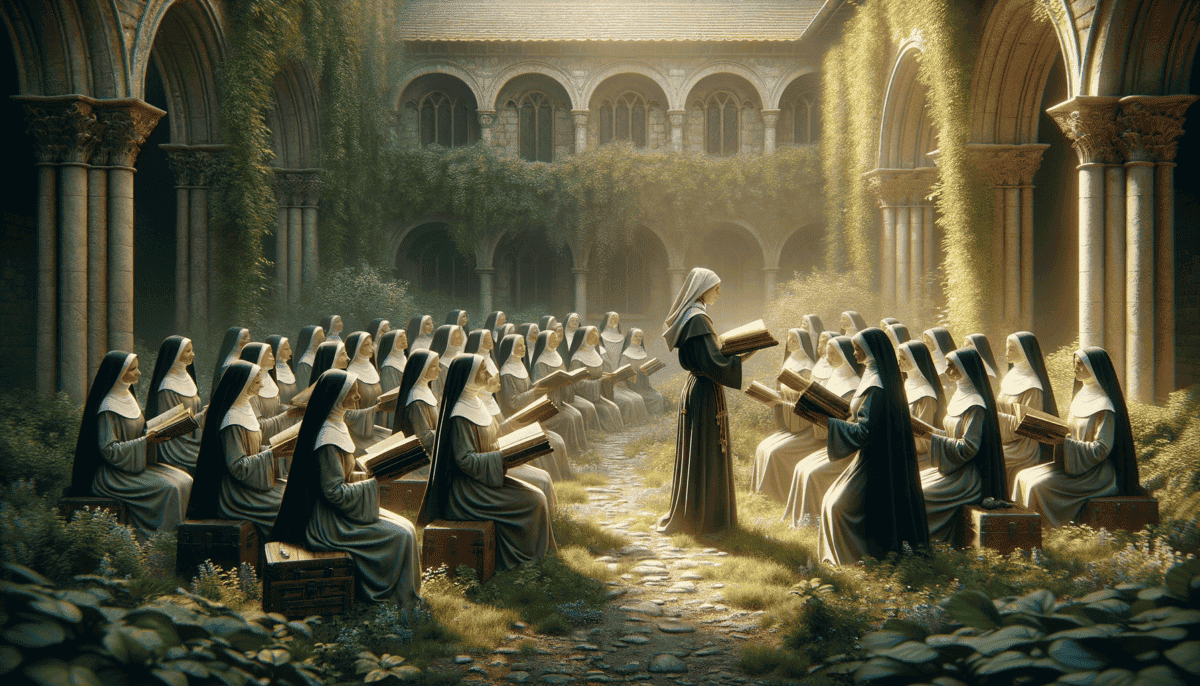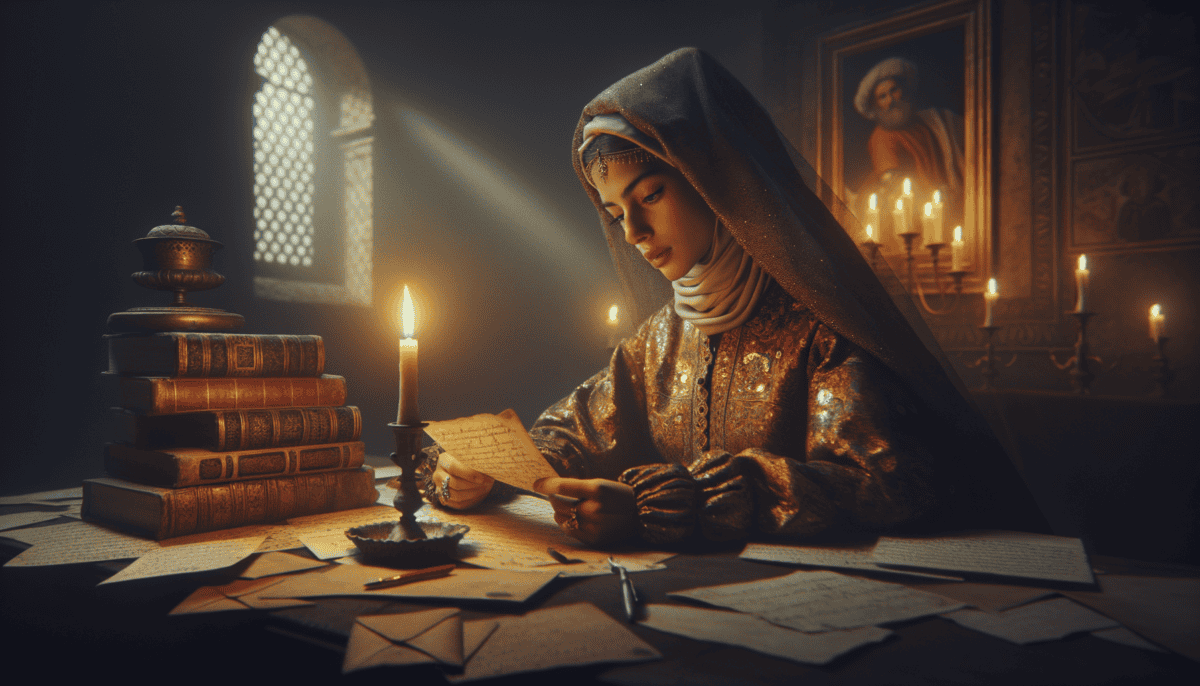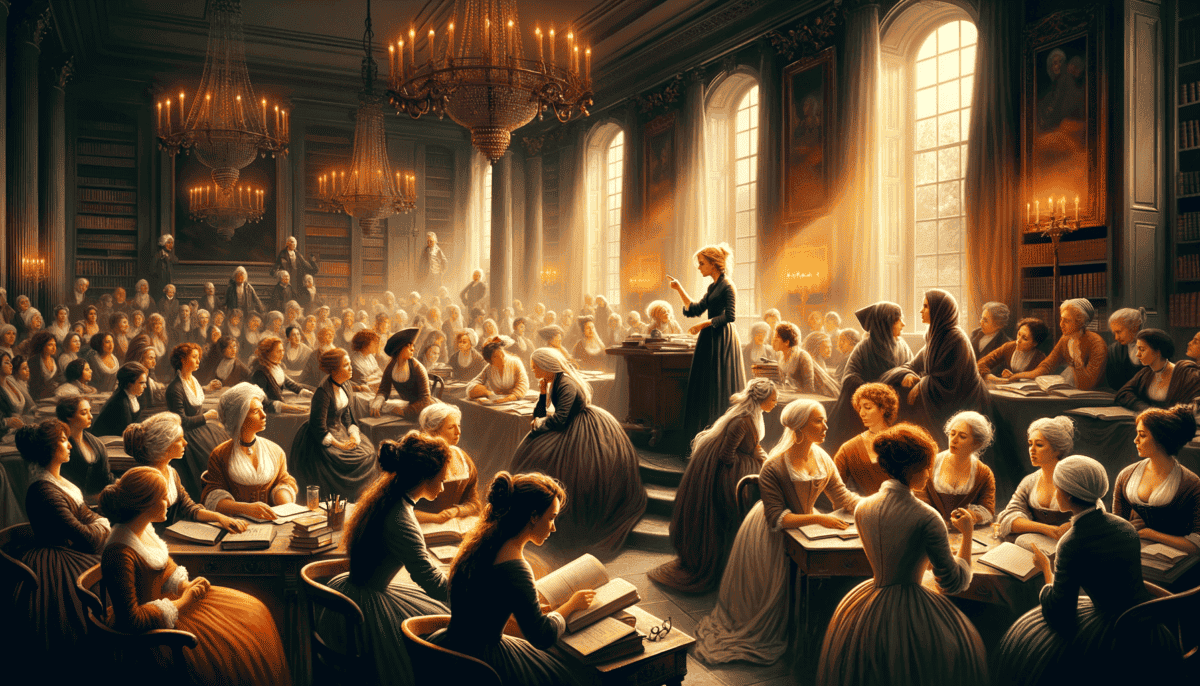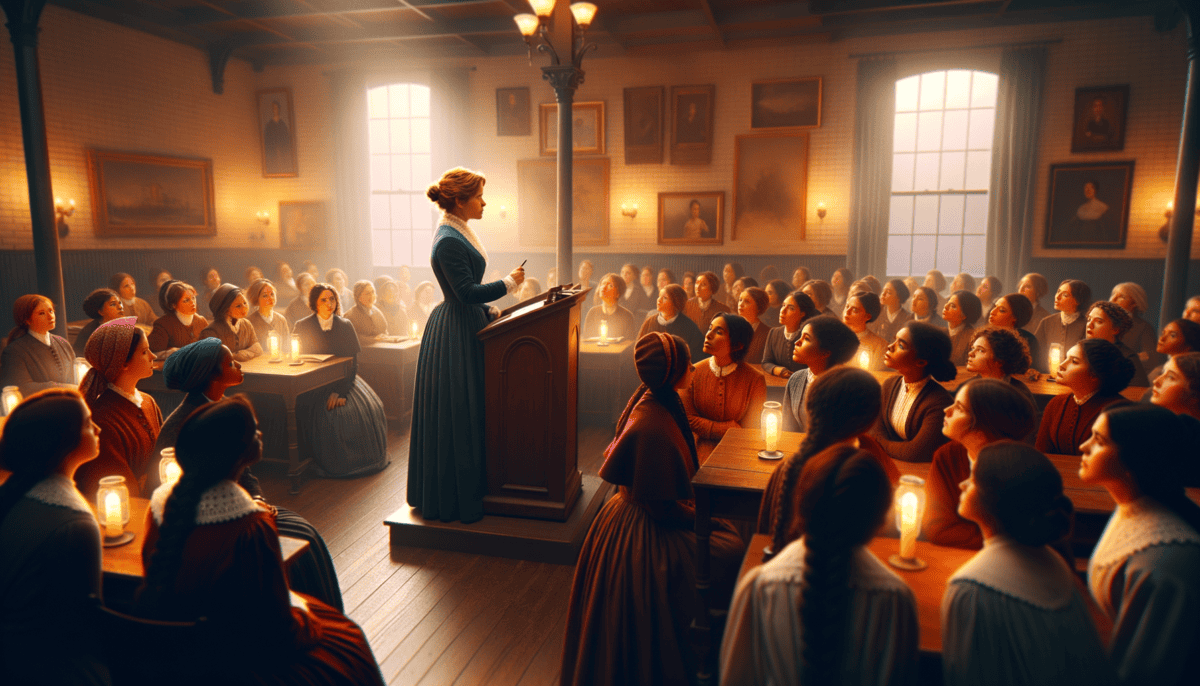The Spark of Learning
Sarah peeked through the curtains of her bedroom window, watching the golden sun rise over the ancient city of Alexandria. The year was 391 CE, and the streets were already bustling with life. But Sarah's eyes were fixed on one particular building in the distance – the Great Library, where the famous teacher Hypatia would soon begin her lessons.
"Sarah!" her mother's voice called from downstairs. "What are you doing up there?"
Sarah quickly stepped away from the window. "Nothing, Mother!"
But it wasn't nothing. Sarah had a secret – she wanted to learn. She wanted to read books and study mathematics just like her brother Thomas. Most of all, she wanted to attend Hypatia's classes.
That morning, Sarah gathered her courage and followed Thomas to the library. She hid behind a large column, watching as students filed into Hypatia's classroom. The teacher stood tall and proud, her dark hair wrapped in a scholarly cloth.
"Today," Hypatia announced in a clear voice, "we will explore the mysteries of numbers."
Sarah's heart beat faster. She leaned forward to hear better, but her foot slipped. CRASH! Several scrolls tumbled from a nearby shelf.
All eyes turned to her hiding spot. Thomas's face turned red with embarrassment. "Sarah! What are you doing here?"
But Hypatia raised her hand for silence. She walked over to where Sarah crouched, trembling.
"Child," Hypatia said softly, "do you wish to learn?"
Sarah nodded, unable to speak.
A Brave Decision
Hypatia smiled. "Then come, sit with us."
The other students – all boys – began to whisper. But Hypatia clapped her hands. "Knowledge," she declared, "belongs to all who seek it. Today, we make history."
Sarah sat next to her brother, who gradually stopped looking embarrassed and started helping her understand the lessons. Together, they drew geometric shapes and learned about the stars.
That evening, Sarah couldn't stop smiling as she told her mother about her day. To her surprise, her mother didn't scold her.
"Your father won't like this," her mother said, but there was a twinkle in her eye. "But perhaps it's time for things to change."
The next day, more girls appeared at Hypatia's class. They sat quietly at first, but soon their hands shot up to answer questions. Their voices grew stronger as they solved problems and shared ideas.
Thomas looked at his sister with new respect. "You know," he said during their walk home, "you're actually pretty good at mathematics."
Sarah beamed. She had done more than learn today – she had helped open a door that would never fully close again. As the sun set over Alexandria, she knew that this was just the beginning of a long journey for girls who wanted to learn.
That night, Sarah wrote in her first scroll: "Today, I learned that wisdom knows no gender. Tomorrow, I will learn even more."
Hidden Knowledge
Sister Maria’s fingers trembled as she carefully turned the page of the ancient manuscript. The candle beside her flickered, casting dancing shadows on the stone walls of the monastery’s scriptorium. It was the middle of the night in 12th century England, and she wasn’t supposed to be here.
“Sister Maria?” A whisper came from the doorway. “Quick, bring the book! Others are coming!”
Sister Maria hurried to join Sister Agnes, clutching the precious book to her chest. They rushed through the dark corridors, their soft shoes making no sound on the cold stone floor.
Inside their small cell, other sisters waited. Young Emma, barely sixteen, sat cross-legged on the floor, her eyes bright with excitement. “Did you bring it?” she whispered.
“Yes,” Sister Maria smiled, opening the book. “Tonight, we learn about the stars.”
The Hidden Library
Behind a loose stone in their cell wall, the sisters had created a tiny library. Books about science, mathematics, and medicine were carefully wrapped in cloth and hidden away.
“Look here,” Sister Agnes pointed to a drawing of the moon’s phases. “This shows why the moon changes shape each night.”
Emma traced the pictures with her finger. “But Sister, why must we study in secret? Isn’t learning a good thing?”
Sister Maria sighed. “Many people think women shouldn’t learn these things. They say we should only pray and do simple work.”
“But that’s not fair!” Emma protested.
“Shhhh,” Sister Agnes cautioned. “That’s why we must be clever. We study at night and teach others in secret.”
A Growing Circle
The sisters didn’t just keep knowledge for themselves. They taught other women who came to the monastery for help. They copied books and sent them to other convents, creating a hidden network of learning.
“Sister Maria,” a voice called softly. It was Sarah, the baker’s daughter who visited them for lessons. “I learned to write my name today!”
Sister Maria hugged her. “Wonderful! Soon you’ll be reading whole books.”
One day, the Abbess herself discovered their secret. The sisters held their breath, fearing punishment. But instead, she smiled.
“I’ve known about your nighttime studies,” she said. “And I think it’s time we brought them into the light.”
The Abbess gave them a special room for their books and lessons. While they still had to be careful about who knew of their studies, they could now teach more openly within the monastery walls.
That evening, Sister Maria wrote in her journal: “Knowledge is like water – it finds a way to flow, even through the smallest cracks. We will keep this stream flowing, drop by drop, until it becomes a river that all can drink from.”
In their quiet corner of the medieval world, these brave sisters were keeping the flame of women’s learning alive, passing it from one generation to the next like a precious torch in the darkness.
Freedom to Learn
The warm Italian sun streamed through the window as Margherita Datini sat at her small desk. It was 1395 in Florence, and she held a quill pen in her trembling hand. At age fourteen, she was doing something most girls couldn’t do – learning to write.
“Keep your letters straight, Margherita,” her tutor Sofia whispered. “Like little soldiers standing in a row.”
Margherita’s tongue poked out as she concentrated. “Like this?” She carefully formed each letter.
“Perfect!” Sofia smiled. “You’re learning faster than any student I’ve had.”
A Secret Agreement
Sofia wasn’t supposed to be teaching Margherita. She had made a deal with Margherita’s father, a rich merchant.
“I’ll teach your daughter to keep business records,” Sofia had told him. “She can help with your shop.”
But Sofia taught Margherita much more. They read poetry, studied history, and learned about science. All hidden between lessons about counting money and writing receipts.
“Look what I found!” Margherita pulled out a book of stories. “Can we read it?”
“Careful,” Sofia warned. “Remember our agreement – business books where others can see, other learning must stay secret.”
Spreading the Knowledge
Margherita wasn’t content just learning for herself. She started teaching her friend Lucia during their afternoon walks.
“Draw the letters in the dirt with a stick,” Margherita showed her. “Then brush them away before anyone sees.”
Soon, other girls joined their secret “walking lessons.” They would pretend to pick flowers while practicing their ABCs.
“My mother says girls don’t need to read,” Lucia sighed one day.
“That’s not true,” Margherita replied firmly. “How can we understand the world if we can’t read about it?”
A Discovery
One day, Margherita’s father found her diary. Her heart stopped as he picked it up. But instead of being angry, he looked proud.
“Your writing is beautiful,” he said. “Perhaps it’s time we stopped hiding your education.”
He turned to Sofia. “Teach her everything. My daughter will be known for her mind, not just her manners.”
Margherita started organizing reading circles for other merchant daughters. They met in her father’s shop, pretending to learn about trade while actually studying everything from poetry to philosophy.
“Education is like a key,” Margherita told her students. “Once you have it, many doors can open.”
Years later, Margherita’s own daughter learned to read and write without hiding. Small changes, like tiny cracks in a wall, were letting the light of learning shine through.
In her garden, Margherita often sat with her books spread around her. She smiled, remembering those first secret lessons. Now she could read under the open sky, and that felt like the greatest freedom of all.
A Time for Change
The year was 1792, and Mary Wollstonecraft stood at her writing desk in London. Her hands were stained with ink as she wrote words that would change history.
“Why shouldn’t girls learn?” Mary said to her friend Jane. “We have minds just like boys do!”
Jane nodded. “But the men say girls only need to learn cooking and sewing.”
Mary’s eyes sparkled with determination. “Well, we’ll show them they’re wrong!”
The First Schools for Girls
Across the ocean in America, Emma Hart Willard had the same dream. She wanted to build a school where girls could learn everything boys learned.
“Girls can study math!” Emma told a group of doubtful parents. “They can learn science and history too!”
In her classroom, Emma taught girls how to:
• Read hard books
• Solve math problems
• Write stories
• Study maps
• Do science experiments
Breaking Down Walls
“Look at this!” Sarah, one of Emma’s students, held up her science experiment. “I made a rainbow in a glass!”
The other girls crowded around, their eyes wide with wonder. They had never been allowed to do experiments before.
“My brother says girls can’t be scientists,” one student said sadly.
Emma smiled kindly. “Tell your brother about Caroline Herschel. She discovered eight comets! Girls can do anything they set their minds to.”
Spreading the Word
Back in England, Mary’s book was causing quite a stir. Some people were angry, but others started to listen.
“Every day, more girls learn to read,” Mary told her daughter. “Every day, more doors open.”
She wrote letters to important people, asking them to support girls’ schools. Slowly, things began to change.
The fight wasn’t over, but brave women like Mary and Emma had started something big. They showed that girls deserved the same chance to learn as boys.
In Emma’s school, a young student wrote in her diary: “Today I learned about planets and poems. Tomorrow, who knows what amazing things I’ll discover?”
And that was just the beginning of a bigger story. More and more girls would get the chance to learn, dream, and change the world.
The First Schools Rise
Emma Hart Willard stood in front of her new school building in Troy, New York. The year was 1821, and her heart was beating fast with excitement.
“Welcome to your first day,” Emma said to the nervous girls at the door. “Today, we make history.”
A New Kind of Classroom
Inside the school, everything was different from what the girls knew. There were maps on the walls, books about science, and even a small laboratory!
“But Miss Willard,” said Lucy, a new student. “My papa says girls shouldn’t study such hard things.”
Emma smiled warmly. “Watch this.” She picked up a piece of chalk and wrote a math problem on the board. “Who wants to solve it?”
The students learned many exciting things:
• Advanced mathematics
• Chemistry and physics
• World geography
• Literature and languages
• Public speaking
Making Dreams Come True
“Look what I made!” Sarah held up a carefully drawn map of the world. Other girls gathered around, amazed by her work.
“Tomorrow we’ll learn about the stars,” Emma announced. The room filled with excited whispers.
Changes Spread Far and Wide
News about Emma’s school traveled fast. Soon, other women wanted to open schools too.
“Miss Catherine Beecher is starting a school in Hartford!” one student announced at breakfast.
“And Mary Lyon is planning Mount Holyoke!” added another.
Emma watched her students grow smarter and more confident every day. She wrote in her diary: “These girls will change the world.”
Fighting for More
But not everyone liked the idea of girls getting a good education. Some people tried to stop the schools from opening.
“They say we’re wasting our time,” said Mary, a senior student.
Emma stood tall. “Every time a girl learns something new, we prove them wrong.”
One day, a father visited the school. He watched his daughter solve complex math problems and conduct science experiments.
“I was wrong,” he told Emma. “Girls can learn anything.”
Emma smiled. She knew this was just the beginning. More schools would open, and more girls would get the chance to learn. The world was starting to change, one classroom at a time.
As the sun set over Troy Female Seminary, Emma watched her students heading home, their arms full of books. She knew that each of these girls would help build a better future – a future where all girls could learn and grow.
Dreams Without Borders
Malala Yousafzai sat in her pink bedroom, writing in her diary. The year was 2009, and she was just 11 years old. In Pakistan, the Taliban had said girls couldn’t go to school anymore.
Standing Up for School
“Why do you still go to school?” her friend Moniba asked one day. “It’s dangerous!”
Malala smiled. “Because every girl deserves to learn. Just like you and me.”
A World of Change
Today, girls all around the world are fighting for their right to learn:
• In Africa, girls walk miles to reach school
• In Asia, girls study by candlelight
• In South America, girls share one textbook between many
• In refugee camps, girls learn in temporary classrooms
Heroes of Today
“Look at this!” Maria shows her classmates a photo on her tablet. It’s a girl in Afghanistan, secretly learning math on a computer.
“When I grow up,” says Sophie from Kenya, “I want to be a teacher and help other girls learn.”
Technology Opens Doors
Girls today have new ways to learn that Emma Willard never dreamed of:
“I take coding classes on my phone!” says Jasmine from India.
“Our whole class connects with students in Japan!” adds Lucy from Canada.
Work Still to Do
But many girls still can’t go to school. Some have to work instead. Others live too far from schools. And in some places, people still think girls shouldn’t learn.
“That’s why we keep fighting,” says Malala, now grown up and helping girls worldwide. “Every girl deserves a chance to learn.”
The Story Continues
From Hypatia in ancient times to Emma Willard’s first school, from secret studies to online classes – girls have always found ways to learn. And they always will.
Today, millions of girls around the world wake up excited to learn something new. They carry backpacks full of books, tablets full of lessons, and hearts full of dreams.
As the sun sets somewhere in the world, a girl opens a book and begins to read. She is part of a long line of brave learners, stretching back through time. And somewhere, another girl is just beginning her journey.






